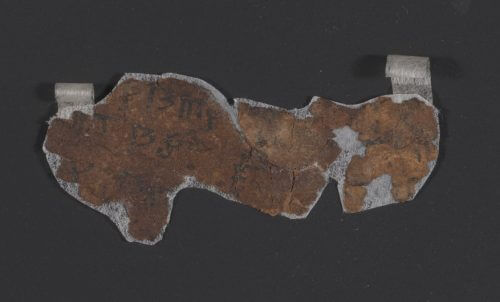After painstaking assembly work of more than 60 tiny fragments, written in hidden script, which lasted over a year, Dr. Ashbel Ratzon and Prof. Yonatan Ben Dov from the Department of Biblical Studies at the University of Haifa succeeded in deciphering and restoring one of the last two scrolls that have not yet been deciphered out of about 900 scrolls Qumran. The prize: another encounter with the unique 364-day calendar of the members of the Judean desert sect, including identification for the first time of the name given by the members of the sect to the special dates of the transition days between the four seasons.

Most of the buried scrolls, the Qumran scrolls, discovered in the 40s and 50s of the last century have already been restored and published. Among the small pieces of the "mosaic" that still remain without a certified reading, sometimes less than a square centimeter, there were about 60 pieces of parchment with hidden writing. A previous researcher who studied the fragments claimed that they belonged to several different scrolls. Now, with the decipherment of Dr. Ratzon and Prof. Ben Dov, published in the Journal of Biblical Literature in a study funded by the National Science Foundation (ISF), it turns out that it is a single scroll. Today there is one more scroll that has not been restored and published, and now the two researchers are working on it as well.
Bani Kumran, who called themselves the "Community of Unity", were an extremist group that retired to desert life, and even suffered persecution from the ruling establishment. They wrote many scrolls, including a small number of scrolls in cryptic writing, and more importantly for the current scroll: they lived according to a 364-day calendar. According to the researchers, the calendar reflects one of the biggest disputes between the different groups of the end of the Second Temple. "The lunar calendar, according to which Judaism practices to this day, requires many human decisions. We need people to look at the stars and the moon and testify to their observations, and we need someone to decide on determining the beginning of the month and the beginning of the year. The 364 day calendar, however, was perfect. Because it is divided into four and seven, the moadim always apply on the same day, and there is no need to wonder what happens, for example, when one of the moadim falls on Shabbat, as sometimes happens in the lunar calendar. There is never any change in the calendar. It reflects, apparently, the perception of the members of the congregation regarding perfection and holiness," the researchers explained.
As mentioned, the current scroll lists the main dates according to the class calendar. The scroll describes two unique times, which were not mentioned in the Bible, but they are known from the "Temple scroll" from Qumran: the firstfruits of the wine and the firstfruits of the oil. These days were a "continuation" of the Shavuot holiday that is customary today and celebrates the firstfruits of wheat. According to this calendar, the Feast of the Firstfruits of Wheat falls 50 days after the Sabbath that follows Passover, after another 50 days the Feast of the Firstfruits of Wine was celebrated and after another 50 days the Feast of the Firstfruits of Oil was celebrated.

Still, it is impossible without surprises: from the previous scrolls, the researchers knew that the members of the congregation celebrated the change of seasons - a special day for each of the four dates of the change of seasons. However, until now they did not know the name of those holidays. In this scroll it was revealed that these days were called "Takupa". "The term is known from the later Sage literature and from the mosaics of the Talmud period, and we could assume that it is used in this sense in the scrolls, but it was revealed here for the first time", explained Dr. Ratzon and Prof. Ben Dov.
The current scroll also sheds additional light on the customs of the scroll writers. It turns out that the person who wrote the scroll - probably one of the leaders of the sect who knew the secret script - forgot to mention some of the community's dates, and another scribe had to correct the mistakes, adding the dates in the spaces between the columns. "The scroll is written in hidden script, but the text itself is a simple and well-known text, which has no reason to hide it. It is a well-known practice at this time in many places outside of Israel, that the leader writes in cryptic writing - even things that are visible to everyone - as part of his status. The custom is meant to show that he is the one who knows the secret script and others do not. But this scroll shows that he got confused quite a few times," the researchers noted.
"In this scroll you can find many words and phrases that appear later in the Mishnah. This shows once again that many things that sages wrote about, several hundred years later, came from an ancient source from the Second Temple period", they concluded.
